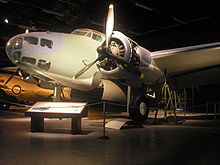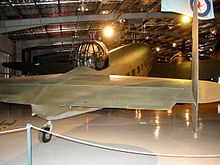Lockheed Hudson
This article needs additional citations for verification. (November 2007) |
| Hudson A-28 / A-29 / AT-18 | |
|---|---|

| |
| Lockheed Hudson Mk V | |
| Role | Bomber, reconnaissance aircraft |
| Manufacturer | Lockheed |
| Designer | Clarence "Kelly" Johnson |
| First flight | 10 December 1938 |
| Introduction | 1939 |
| Primary users | Royal Air Force Royal Canadian Air Force Royal Australian Air Force United States Army Air Forces |
| Produced | 1938-1942 |
| Number built | 2,584 |
| Developed from | Lockheed L-14 Super Electra |
The Lockheed Hudson was an American-built light bomber and coastal reconnaissance aircraft built initially for the Royal Air Force shortly before the outbreak of the Second World War and primarily operated by the RAF thereafter. The Hudson was the first significant aircraft construction contract for the Lockheed Aircraft Corporation—the initial RAF order for 200 Hudsons far surpassed any previous order the company had received. The Hudson served throughout the war, mainly with Coastal Command but also in transport and training roles as well as delivering agents into occupied France. They were also used extensively with the Royal Canadian Air Force's anti-submarine squadrons.
Design and development
In 1938, the British Purchasing Commission sought an American maritime patrol aircraft for the United Kingdom to support the Avro Anson. On 10 December, 1938, Lockheed demonstrated a modified version of the Lockheed L-14 Super Electra commercial airliner, which swiftly went into production as the Hudson Mk I. By February 1939, Hudsons began to be delivered, initially equipping No. 224 Squadron RAF at RAF Leuchars, Scotland in May 1939. By the start of the war in September, 78 Hudsons were in service.
A total of 350 Mk I and 20 Mk II Hudsons were supplied (the Mk II had different propellers). These had two fixed Browning machine guns in the nose and two more in a Boulton Paul dorsal turret. The Hudson Mk III added one ventral and two beam machine guns and replaced the 1,100 hp Wright Cyclone 9-cylinder radials with 1,200 hp versions (428 produced).
The Hudson Mk V (309 produced) and Mk VI (450 produced) were powered by the 1,200 hp Pratt & Whitney Twin Wasp 14-cylinder two-row radial. The RAF also obtained 380 Mk IIIA and 30 Mk IV Hudsons under the Lend-Lease programme.
Operational history
Although later outclassed by larger bombers, the Hudson achieved some significant feats during the first half of the war. On 8 October, 1939, over Jutland, a Hudson became the first RAF aircraft to shoot down a German aircraft. (The accolade of the first British aircraft to shoot down a German plane went to the Blackburn Skua of the Fleet Air Arm on 26 September, 1939.) They operated as fighters during the Battle of Dunkirk. A PBO-1 Hudson of US Navy squadron VP-82 became the first US aircraft to destroy a German submarine [1] when it sank U-656 southwest of Newfoundland on 1 March 1942. A Hudson of Royal Canadian Air Force Bomber Reconnaissance Squadron 113 became the first aircraft of RCAF's Eastern Air Command to sink a submarine, when Hudson 625 sank U-754 on 31 July 1942.[2]
A Royal Australian Air Force Hudson was involved in the Canberra, Australia air disaster of 1940, in which three cabinet ministers of the Australian government were killed.
In 1941, the USAAF began operating the Hudson; the Twin Wasp-powered variant was designated the A-28 (82 acquired) and the Cyclone-powered variant was designated the A-29 (418 acquired). The US Navy operated 20 A-28s, redesignated the PBO-1. A further 300 were built as aircrew trainers, designated the AT-18.
Following Japanese attacks on Malaya, Hudsons from No. 1 Squadron RAAF became the first aircraft to make an attack in the Pacific War, sinking a Japanese transport ship, the IJN Awazisan Maru, off Kota Bharu, an hour before the attack on Pearl Harbor. During the war, they were used as maritime patrol aircraft in the Pacific by the US Navy, the RAAF and the Royal New Zealand Air Force.
They were operated by RAF Special Duties squadrons for clandestine operations; No. 161 Squadron in Europe and No. 357 Squadron in Burma.
A total of 2,584 Hudsons were built. They began to be withdrawn from front line service in 1944.
The type formed the basis for development of the Lockheed Ventura.
Variants
- Hudson I
- Production aircraft for the Royal Air Force, 351 built and 50 for the Royal Australian Air Force
- Hudson II
- As the Mk I but with spinnerless constant speed propellers, 20 built for the RAF and 50 for the RAAF.
- Hudson III
- Production aircraft with retractable ventral gun position, 428 built.
- Hudson IIIA
- Lend-lease variants of the A-29 and A-29A aircraft, 800 built.
- Hudson IV
- As Mk II with ventral gun removed, 30 built and RAAF Mk I and IIs were converted to this standard.
- Hudson IVA
- 52 A-28s delivered to the RAAF.
- Hudson V
- Mk III with two 1200hp R-1830-S3C4-G engine, 409 built.
- Hudson VI
- A-28As under lend-lease, 450 built.
- A-28
- US Military powered by two 1050hp R-1830-45 engines, 52 delivered to Australia as Hudson IVA.
- A-28A
- A-28 with convertible interiors as troop transports, 450 delivered to RAF as Hudson VI. 27 units passed to the Brazilian Air Force
- A-29
- A-28 powered by two 1200hp R-1820-87 engines, 416 built for the RAF, 153 diverted to USAAF as the RA-29 and 20 to the United States Navy as the PBO-1
- A-29A
- A-29 with convertible interiors as troop transports, 384 to the RAF as Hudson IIIA, some retained by USAAF as the RA-29A.
- A-29B
- 24 repossesed A-29s converted for photo-survey.
- AT-18
- Gunnery trainer version of the A-29 powered by two R-1820-87 engines, 217 built.
- AT-18A
- Navigational trainer version with dorsal turret removed, 83 built.
- C-63
- Provisional designation changed to A-29A.
- C-111
- Three civil Model 14s impressed in Australia.
- PBO-1
- Twenty former RAF Hudson IIIAs repossesed for use by VP-82 Squadron of the United States Navy
Operators


- Royal Air Force
- No. 24 Squadron RAF
- No. 48 Squadron RAF
- No. 53 Squadron RAF
- No. 59 Squadron RAF
- No. 62 Squadron RAF
- No. 117 Squadron RAF
- No. 139 Squadron RAF
- No. 161 Squadron RAF
- No. 163 Squadron RAF
- No. 200 Squadron RAF
- No. 203 Squadron RAF
- No. 206 Squadron RAF
- No. 212 Squadron RAF
- No. 217 Squadron RAF
- No. 220 Squadron RAF
- No. 224 Squadron RAF
- No. 231 Squadron RAF
- No. 233 Squadron RAF
- No. 251 Squadron RAF
- No. 267 Squadron RAF
- No. 269 Squadron RAF
- No. 271 Squadron RAF
- No. 279 Squadron RAF
- No. 285 Squadron RAF
- No. 287 Squadron RAF
- No. 288 Squadron RAF
- No. 289 Squadron RAF
- No. 353 Squadron RAF
- No. 357 Squadron RAF
- No. 500 Squadron RAF
- No. 517 Squadron RAF
- No. 519 Squadron RAF
- No. 520 Squadron RAF
- No. 521 Squadron RAF
- No. 608 Squadron RAF
Survivors

- Australia
- RAAF Hudsons can be found at the Temora Aviation Museum, the Australian War Memorial and the RAAF Museum. Other ex-RNZAF and RAAF machines are in private hands. One aircraft, in Australia, was converted for passenger use and flown by East West Airlines.
- Canada
- One complete and several partial Hudsons also exist in Canada. A Lockheed Hudson Mk IIIA (T9422) after years mounted on a pedestal near Washington Street, is on outdoor display at the North Atlantic Aviation Museum, Gander, Newfoundland.
- New Zealand
- Former Royal New Zealand Air Force Hudsons which saw service during the Second World War in the South Pacific are on display at the Royal New Zealand Air Force Museum and Ferrymead Heritage Park in Christchurch and the Museum of Transport and Technology in Auckland.
- United Kingdom
- A Hudson in Royal Australian Air Force colours is preserved in the Royal Air Force Museum at Hendon.
Specifications (Hudson Mk I)
General characteristics
- Crew: 6
Performance
Armament
- Guns: 4× .303 in (7.7 mm) Browning machine guns
- 2× in nose
- 2× in dorsal turret
- Bombs: 750 lb (340 kg) of bombs or depth charges
Popular culture
1941- "A Yank in the RAF" with Tyrone Power and Betty Grable, Lockheed Hudsons are the bombers flown by Power and his squadron.
- The Lockheed Hudson features prominently in the Captains of the Clouds (1942). The film starred James Cagney and Dennis Morgan as Canadian bush pilots who do their part in the Second World War as ferry pilots, bringing Hudsons to Britain. The film ends with a depiction of a Hudson ferry flight that mixes authentic live action with studio footage.
- Above and Beyond (2006) Canadian Broadcasting Corporation (CBC) four-hour mini series was inspired by the true story of the Atlantic Ferry Organization, recounting the daring plan to deliver aircraft across the North Atlantic to the beleaguered Royal Air Force. The Lockheed Hudson is the primary aircraft portrayed in the mini series in the form of a real life example and numerous CGI Hudsons.[3]
- The Lockheed Hudson was featured in the movie "The Great Raid" as a distraction to Japanese soldiers, although in the real event, a P-61 Black Widow was used. The Hudson was used instead because there were no airworthy Black Widows at the time of the movie's filming.
See also
Related development
Aircraft of comparable role, configuration, and era
Related lists
- List of aircraft of the RAF
- List of aircraft of the RNZAF
- List of military aircraft of the United States
- List of Lockheed aircraft
References
- ^ Swanborough, Gordon, and Bowers, Peter M., "United States Navy Aircraft since 1911", Naval Institute Press, Annapolis, Maryland, 1976, Library of Congress card number 90-60097, ISBN 0-87021-792-5, pages 505.
- ^ The Creation of a National Air Force W.A.B. Douglas, (University of Toronto Press, 1986) p. 520
- ^ CBC.ca - Above & Beyond
